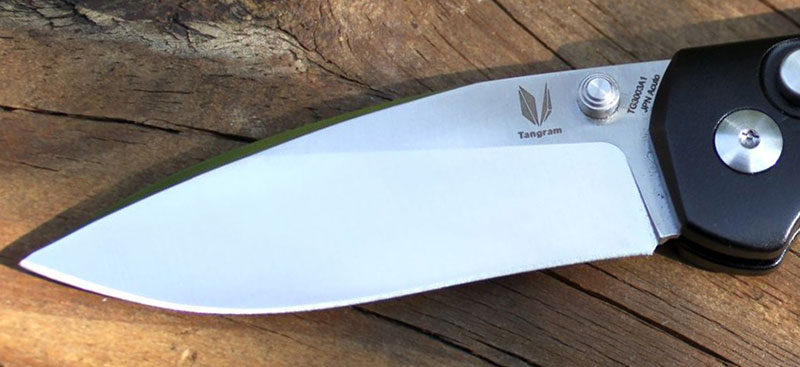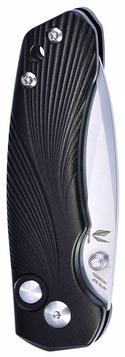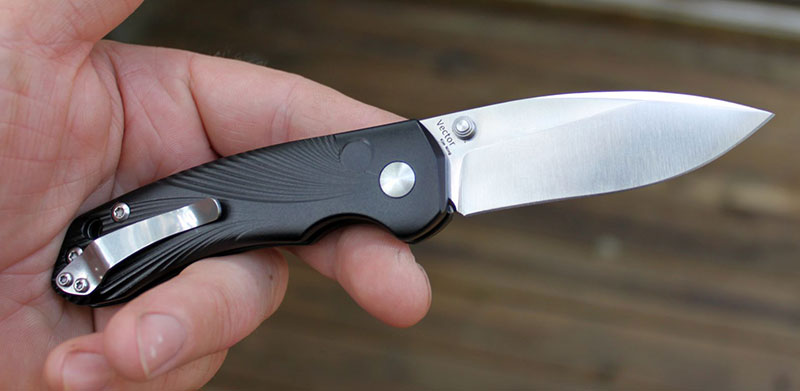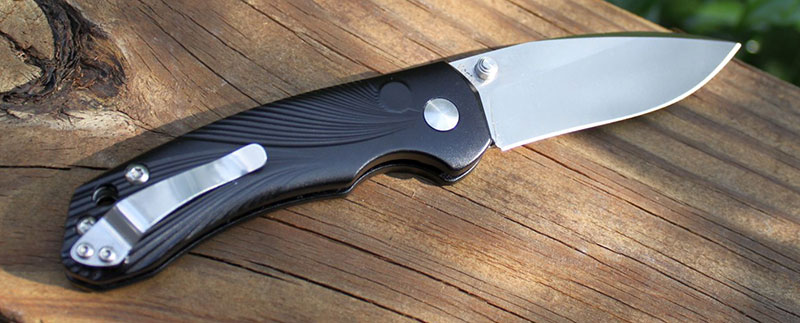We independently evaluate all recommended products and services. Any products or services put forward appear in no particular order. If you click on links we provide, we may receive compensation.
The past year has seen a pretty glorious resurgence of high-quality affordable (or budget) knives, which has been a refreshing change from previous year’s trends of a never-ending pile of contoured titanium framelock flippers with crazy steels and $400 MSRP’s. It’s not that I don’t like Spyderco Nirvanas, but the knives people actually buy – and more importantly, the knives that people actually use- are usually much lower on the price scale. So seeing this segment get some more attention – in a number of creative ways – is awesome.

Key Specs: Tangram Vector
While Tangram has budget prices (generally at or below $40) they all use Acuto 440 steel and are made with the same impressive build quality as the rest of Kizer’s lineup. Today we’re examining the interesting Tangram Vector, which is a design by Kim Ning, and also the first button lock in Kizer’s lineup. It’s more of a stylish gentleman’s folder than the rest of the slightly tactical-oriented Tangram lineup – so we’re going to take a look at the Vector and see if this budget challenger is a hit or a miss.
The Blade
The Vector is smaller than the other two Tangrams sent to us for review (the Progression and Orion) coming in under the arbitrary 3” blade limit that lots of municipalities apply to blade length. At 2.89” it’s more than long enough to cut stuff, but not so big it’s going to scare people or put you on an FBI watch list. Blade stock is fairly reasonable at 2.5mm (or about 0.10”) considering the size of the knife. The blade shape and grind is interesting, ostensibly a modified drop point – the Vector has an angled primary bevel that’s reminiscent of Hinderer’s “slicer grind”, a long false swedge along the spine, and a minor recurve to the edge. That primary bevel is flat ground, and I think the Vector’s cutting performance would benefit from a hollow grind but perhaps the price point on this knife prohibits that.

Blade steel is Acuto 440, which according to Kizer is closest to traditional 440C in composition. 440C has always been a good stainless cutlery steel going back a long time, similar to VG-10 and a step above AUS-8 or 8Cr in terms of performance. Kizer vacuum heat treats Acuto 440 to a Rockwell hardness between 58-60, which is pretty high for 440C, giving it good edge retention performance. Compared to 440C, Acuto 440 has more molybdenum (corrosion resistance, machine-ability, strength, larger carbide size) and less manganese (smaller grain size, purifies steel). Carbon and Chromium contents are largely similar between the two, the primary elements defining edge retention and corrosion resistance in a stainless steel. Expect similar performance to 440C but with larger grain size, basically. (Small grain size being the hallmark of a steel taking a clean, fine edge.)
Deployment and Lockup
The big news about the Vector is the button lock, also referred to as a plunge lock. This isn’t a lock type typically seen in this price range, generally populated by liner locks and lockbacks, so it’s what sets the Vector apart in this range.

I’m not totally sold on the implementation here. I’ve used a few button locks on Hogue products – which admittedly are a good bit more expensive – and this isn’t quite up to that level. This doesn’t use a detent on a separate spring plate like the Hogue X-1 and X-5, instead relying on a stepped lip where the lock rests against the blade to provide a detent, and it’s fairly soft. Not so soft that you can shake the knife open when it’s closed without depressing the button, but it doesn’t make it much of a snappy opener.
 The Vector rides on phosphor-bronze washers paired up with paper-thin Teflon washers instead of ball bearings like the other Tangram models, and they hold the action back a little bit as to be expected. If you loosen the pivot a touch to make closing smooth, it introduces noticeable horizontal blade play when open. If you tighten it down enough to eliminate the blade play, the knife will pop open with a wrist flick but there’s too much friction for it to drop shut. You can fiddle with this endlessly with a Torx T8 screw driver, and you can never get it quite right – I’ve tried.
The Vector rides on phosphor-bronze washers paired up with paper-thin Teflon washers instead of ball bearings like the other Tangram models, and they hold the action back a little bit as to be expected. If you loosen the pivot a touch to make closing smooth, it introduces noticeable horizontal blade play when open. If you tighten it down enough to eliminate the blade play, the knife will pop open with a wrist flick but there’s too much friction for it to drop shut. You can fiddle with this endlessly with a Torx T8 screw driver, and you can never get it quite right – I’ve tried.
It also suffers from the same annoyance that some compression lock knives do, in that it is too easy for the blade to “bounce” back out when you’re trying to swing it shut. I’ve found holding the lock and swinging the handle in a “J” shape gives you the best chance of closing it smoothly. Some practice is required. You can also swing the knife open by holding the lock down, but this is tricky as it likes to bounce off the stop pin and not lock open. I’ve also noticed that the lock button catches and “clicks” on something when you push it past where it interfaces with the blade tang, but this doesn’t seem to have any functional effect.
The plunge lock itself engages across probably 75% of the lock face on the tang which is very secure, with no vertical blade play. I’ve also not noticed any lock stick when unlocking the blade which some other plunge lock knives suffer from during break-in.
Features, Fit & Finish
The Vector is definitely a nice looking pocket knife, thanks to the slick anodized aluminum handles. My test sample was black, but Tangram also sells the Vector in a really attractive bright blue color as well. The handles are what catch people’s eyes: those series of flowing, aquatic looking lines milled into the handles on both sides give it an organic look. I’m not a huge fan of anodized aluminum when it comes to actually using a knife (see below) but it looks great.

The Tangram uses all Torx T8 fittings for the body and pivot screws, and Torx T6 screws to secure the pocket clip. The pivot is a Chicago style screw, and the female side is secured in place with a D-shape on the barrel that is keyed to the handle scale to prevent it from turning when you loosen or tighten the pivot. Construction is flow-through, with a set of pair of polished stainless hourglass-shaped standoffs towards the rear of the handle. Curiously, despite the aluminum handles the Vector still uses nested stainless liners which are skeletonized to save weight – I’m not sure if using these versus just solid aluminum handles is a cost saving measure or if it’s for structural reasons. This does mean that the screws for the pocket clip thread into steel instead of aluminum, which is a good thing in my book.

Speaking of clips, the Vector has a standard stainless spring-style clip that is only tapped for right hand tip-up carry: sorry lefties. The button lock interferes with possible tip down mounting (but, why would you want that in the first place?) and the curved shape of the clip means it would be wrong on the other side. Considering the vast majority of people are right-hand-tip-up carriers this isn’t a huge deal. It’s not a deep carry style fold over clip but it does mount at the very edge of the handle so the Vector rides pretty low in pocket. The Vector features a lanyard hole sans tube between the two standoffs.
As far as visible construction quality goes, this doesn’t really look like a $45 knife. The factory edge grind is ever so slightly asymmetrical – it’s wider towards the tip on the lock side – but otherwise the complex blade shape is well executed, with the edge grind staying remarkably straight through the recurved portion. Like most Kizers there’s a lot of branding on the blade, but it’s not particularly large or garish: the Tangram name and logo as well as the model number and “JPN Acuto” on one side, and “Vector – Kim Ning” on the other, behind the thumb stud.
Field Test
The Vector carries pretty well. It’s not as thin as another similarly sized knife we’ve reviewed, the James Brand Folsom, but at 3.4 ounces and with a well-positioned spring clip it doesn’t weigh you down. The spine protruding from the handles makes it pretty round, sort of like the Manix 2, so it does take up a fair bit of pocket space, and having slick aluminum handles means it can pivot and slide around a bit.

It’s not bad to use, though. The shape of the handle has good ergonomic form, with a bit of contouring making it fill up the hand, and a well-defined forefinger choil and a broad arc for your other three fingers to locate it. I don’t like sharpening recurves but I do like cutting with them when they’re mild like this one: as you pull the knife towards you while it’s in whatever material you’re slicing, it traps the material in the concave portion of the sharpened edge and makes it easier to cut.
The traditional drop point profile is still my favorite for EDC tasks, making piercing thick materials (like plastic clamshell packaging) an easy ordeal but leaving enough thickness behind the tip that it’s not prone to snapping off. As with all knives I wish the Vector had a forward finger choil for greater blade control, but that’s unlikely with the overall size of the knife.

Another thing the Vector lacks in its entirety is any jimping – which makes sense with the smooth, slick feel of the knife but would definitely be useful here. Maybe just a bit on the spine above the thumb stud or some under your pinky finger. This is exacerbated by the anodized aluminum handles, which are the absolute slickest surface for a knife handle.
In my job as a mechanic I’m frequently wearing textured orange nitrile gloves with some kind of oil or brake fluid on them, and the Vector basically felt like a bar of soap in those situations where something grippier – like G10 or Spyderco’s bidirectional textured FRN – doesn’t feel any different. There’s no friction to the surface, and those flutes or grooves are more decorative than functional. If you work in the Vaseline factory, to paraphrase a certain YouTube knife reviewer, this isn’t the knife for you.
During my testing period, I never had any actual issues with lockup or blade retention when closed, so in that regard the button lock was a success, but I never did warm up to the action of the knife. An addictive fidget tool it’s not – the previously tested Tangrams (especially the Orion) with their bearing pivots were more fun in that regard. Do keep in mind that you won’t be able to use a standard guided rod system with flat stones to sharpen the Vector due to the recurve; I never bothered as it stayed sharp enough to slice paper during my testing.
Alternatives
All these knives available at BladeHQ.
Here’s the issue with the Vector: it’s the most expensive of the Tangram line, at $45 when most of the other models are around $30. And that puts it within a Chick-Fil-A combo meal of the Kizer Vanguard Begleiter, which at the time of writing retails for about $50 on Amazon Prime. Like the Vector it uses a combination of phosphor bronze and Teflon washers with a thumb stud for action, but it has a tried and true liner lock. Blade steel is also VG-10 which is a step up from the 440C/Acuto on the Tangram line of knives. It’s a bit bigger with a 3.3” blade but has a slimmer profile in pocket.
In the budget price range, you can’t ignore the force of nature that has been the CRKT Pilar. While I’d like to recommend some of the exclusives that have been put out – the G10 handled versions or the carbon fiber/S35VN variant – they’re sadly sold out, leaving only the standard stainless handle, 8Cr13MoV model. At $25 it’s a lot cheaper than the Vector, and it’s also heavier and has worse steel. But it’s a great little box cutter.

An interesting new alternative in this price and size range is the Ruike P671-CB (what a model name!). It’s got a liner lock and carbon fiber scales, and allows you to choose between a front flipper and a pair of thumb studs, which appear to be removable. Blade steel is Sandvik 14c28n which is a great deal at the $40 retail price this new design goes for. Size is similar with a 2.75” drop point blade and 6.50” OAL, although it’s a touch heavier at 3.7 ounces. An interesting left field choice.

You can’t discuss budget blades without bringing up what in my opinion is the leader in this class, the most excellent $38 Steel Will Cutjack Mini (FRN) model. It has skeletonized nested stainless liners, a slick liner lock, reliable flipper deployment on phosphor bronze washers, and a satin finish drop point blade in tough D2 tool steel. It’s not perfect but it’s a very likable budget entry. The Vector’s blade will have slightly worse edge retention but much better corrosion resistance.

And finally, there’s the new Sinkevich-designed Kershaw Atmos budget folder. At ~$32 retail, the combination of carbon fiber scales and a bearing pivot flipper action are surprising. But while the Atmos uses some cheap materials (notably the 8Cr13MoV blade steel), it has some real design chops that speak to disciples of the school of EDC: it’s ultra-thin, super light, and its thin hollow ground blade makes it an excellent slicing tool.
Wrap-up
It took me a while to get my head around the Vector. It seems like a classic form over function knife at first glance, with its nifty plunge lock and flowing aluminum handles seemingly placing looks and fidget factor over usability. But it’s not a total dud – there is the excellent budget steel that Kizer chose to use here, as well as the classic drop point shape and the performance benefits of the recurved blade.

And not every knife must have denim-destroying G10 and lines of aggressive jimping to scare soccer moms; something you just want something cool and slick to drop into your pocket on the weekend, and the Vector fits the bill the same way the interesting-but-flawed CRKT Swindle does: it’s a conversation piece, and it’s something different in this price range. Of course, if the Vector is intended as a gentleman’s folder, then it’s a bit on the wide and tall side for fitting into trim slacks.
I think the issue is that Kizer itself kills the Vector in this price range with similarly affordable Vanguard-line knives, which offer grippy G10 handle scales and better performing VG-10 steel, like the aforementioned Begleiter as well as the absolutely excellent Laconico Gemini. I ended up liking this the least of the three Tangram models that Kizer generously provided for review, preferring the slicker action and more function-oriented scales of the Progression and especially the Orion folders. Still, there’s something to be said for this eye-catching knife – especially in that atomic-glow blue they offer it in.
- Aluminum scales and a button lock in a field full of G10 and liner locks, likable budget steel, performance benefits of mild recurve
- Lack of traction in slippery conditions, difficult to sharpen a recurve, issues with balancing action vs blade play via pivot tension, the Vanguard line of knives
Tangram Vector
Quality/Performance - 63%
Value for Money - 73%
68%
The Tangram Vector proves to be a slick-literally and figuratively- EDC knife with equal amounts of charm and flaws.





